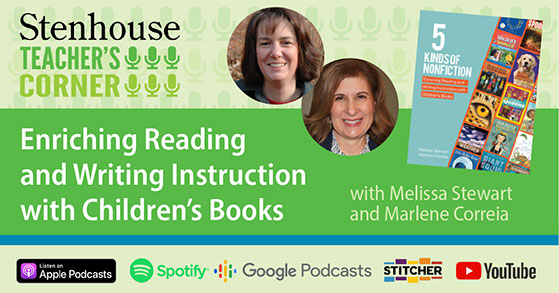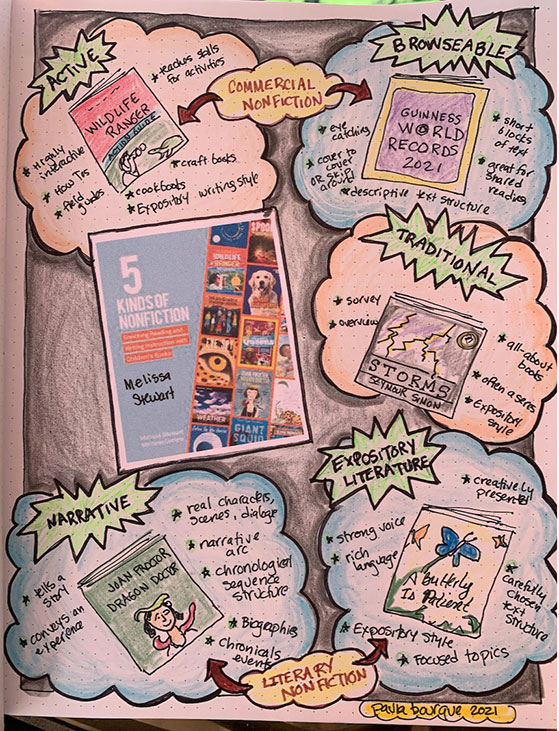 |
| Enriching Reading and Writing Instruction with Children's Books |
|
| Nonfiction for children has undergone exciting changes in recent years, evolving into a new breed of visually dynamic, engaging texts that delight as well as inform. The timing of these groundbreaking changes couldn’t be better, as ELA standards put an increased focus on nonfiction reading and writing. As a result, finely crafted nonfiction children’s books are ideally suited for augmenting content area curricula, serving as reliable resources for research projects, acting as mentor texts for writing workshop and, as always, serving as a great source for pleasure reading. |
|
| In 5 Kinds of Nonfiction: Enriching Reading and Writing Instruction with Children’s Books, present a simple, practical system for sorting nonfiction into five major categories (active, browseable, traditional, expository literature, and narrative) and describe how classifying books in this way can help teachers and students effectively utilize the books in a school setting. Along the way, they: |
|
- explore each of the categories through discussions, classroom examples, and insights from leading children’s book authors
- offer tips for building strong, diverse classroom and library collections
- provide more than 20 small group, whole-class, and whole-school activities to enhance literacy instruction
- include innovative strategies for sharing and celebrating nonfiction with students
|
|
| With more than 150 exemplary nonfiction book recommendations and Stewart and Correia’s extensive knowledge of literacy instruction, 5 Kinds of Nonfiction will elevate your understanding of nonfiction in ways that speak specifically to the info-kids in your classrooms, but will inspire all readers and writers. |
|
 |
|
| PODCAST: "Enriching Reading and Writing Instruction with Children's Books," with Melissa Stewart and Marlene Correia, hosted by Stenhouse Teacher's Corner |
|
| Reviews |
|
| “I read this book cover to cover—it’s the most important, well-written professional development book that I’ve read in years; sure to inspire and transform classrooms and libraries for the better … It’s a game-changer for how we understand, teach, and use nonfiction with our students.” |
|
| —Melissa Taylor, former teacher and children’s book reviewer at Imagination Soup (full review) |
| |
| “This really is a book teachers will want to take the time and read … it has direct correlations to so many parts of your curriculum.” |
|
| —Michele Knott, elementary literacy specialist (full review) |
|
| “I learned so much from reading 5 Kinds of Nonfiction. The authors descriptions of each type of nonfiction with examples of children’s picture books really helped me understand the classification. I am more aware of how I favor narrative nonfiction and will look for ways to balance out my read alouds and book talks with more expository choices. The lessons and activities all align with my views of immersing children in real books and real purposes for writing. I highly recommend 5 Kinds of Nonfiction for educators who want to dive deeper into the world of nonfiction and present more options and possibilities for students.” |
|
| —Kathleen Sokolowski, third grade teacher (full review) |
| |
| “Absolutely LOVE this new book! Your students will never look at nonfiction the same way again! It’s filled with great ideas and lessons to help kids comprehend, appreciate, and love nonfiction more.” |
|
| —Paula Bourque, elementary literacy coach, author of Close Writing and Spark! |
|
 |
|
| “Having experience with the 5 Kinds of Nonfiction will help students know what to expect when choosing nonfiction to read. When seeking out books for research, students make more conscious and appropriate choices based on their topic and purpose.” |
|
| —Kristen Picone, fifth grade teacher |
|
| “Teaching students about the 5 Kinds of Nonfiction opens up options for critical thinking and choice in their own writing.” |
|
| —Jen Vincent, middle school language arts/social studies teacher |
|
| “The 5 Kinds of Nonfiction classification system brings clarity to the way we think about nonfiction. We’re used to subdividing our fiction section into genres like mysteries and science fiction. But then we just lump all the nonfiction together. Now we can see smart, useful ways to categorize these books too.” |
|
| —Traci Kirkland, elementary school librarian |
|
| “The 5 Kinds of Nonfiction classification system enables students to view nonfiction through new lenses, affording them the opportunity to think more deeply and critically about the format and presentation of content.” |
|
| —Ruth McKoy Lowery, professor of literacy |
|
| “The 5 Kinds of Nonfiction really pushed [students] to engage with the texts and played on their natural curiosity to organize and make sense of the seemingly random materials.” |
|
| —Abi Diaz, middle school language arts/social studies teacher |
|
| “After learning about the five different categories, students had vocabulary to talk about the books they enjoyed reading and why they enjoyed it.” |
|
| —Tom Bober, elementary school librarian |
|
| Behind the Book |
|
| “In an effort to better understand the wide world of nonfiction books for children, I began developing a nonfiction family tree in 2012. My goal was to identify the various categories of books available and show the relationships among them. I published a few different versions of the family tree on my blog, but none of them seemed quite right. |
|
| “In 2013, I learned that a group of highly-respected educators who called themselves the Uncommon Corps had developed a nonfiction taxonomy. I was fascinated by their ideas. Although the group’s classification system never caught on, I began an ongoing dialogue with several members. Marc Aronson, Sue Bartle, Mary Ann Cappiello, and Myra Zarnowski have all influenced the way I think about nonfiction. |
|
| “Over the next four years, I continued to refine my thinking, and by December 2017, my family tree seemed truly useful. When I posted it on my blog, the response was tremendous. Teachers, librarians, children’s book authors, and editors all loved the idea of classifying nonfiction into five categories—active nonfiction, browseable nonfiction, traditional nonfiction, expository literature, and narrative nonfiction. People praised the clarity the classification system brought to the range of children’s nonfiction available today. |
|
| “Eventually, I realized that a tree model wasn’t the most effective way to represent my ideas, and she began referring to her classification system as the 5 Kinds of Nonfiction. |
|
| “In 2018, Stenhouse editor Terry Thompson saw me give a presentation about the 5 Kinds of Nonfiction at nErDcamp in Parma, Michigan, and invited me to write a book about the classification system for educators. I liked the idea, but knew, I’d need a partner who had teaching experience as well as a love of nonfiction for kids. Marlene Correia, Assistant Professor of Literacy Education at Bridgewater State College, was the perfect choice.” |